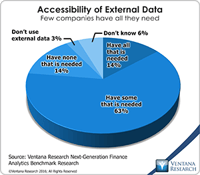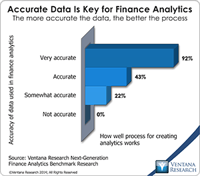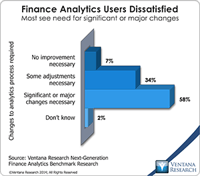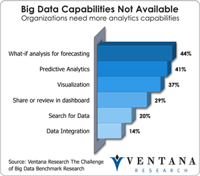Using information technology to make data useful is as old as the Information Age. The difference today is that the volume and variety of available data has grown enormously. Big data gets almost all of the attention, but there’s also cryptic data. Both are difficult to harness using basic tools and require new technology to help organizations glean actionable information from the large and chaotic mass of data. “Big data” refers to extremely large data sets that may be analyzed computationally...
Read More
Topics:
Big Data,
Data Science,
Planning,
Predictive Analytics,
Social Media,
FP&A,
Office of Finance,
Operational Performance Management (OPM),
Budgeting,
Connotate,
cryptic,
equity research,
Finance Analytics,
Human Capital,
Kofax,
Statistics,
Analytics,
Business Analytics,
Business Intelligence,
Customer Performance Management (CPM),
Data,
Datawatch,
Financial Performance Management (FPM),
Kapow,
Sales Performance Management (SPM),
Supply Chain Performance Management (SCPM),
Strata+Hadoop
Analytics has long been a core discipline of Finance, applied to analysis of balance sheets, income statements and cash-flow statements. However, as I’ve noted, most finance departments have not kept up with recent advances. Our recent research in finance analytics shows that few organizations are realizing the potential of more advanced analytic methods and tools such as predictive analytics and driver-based modeling. One reason for this sluggishness is that they have not looked past...
Read More
Topics:
ERP,
FP&A,
Office of Finance,
Controller,
Finance Analytics,
Business Analytics,
Business Performance Management (BPM),
CFO,
Financial Management,
Financial Performance Management (FPM)
Our research consistently finds that data issues are a root cause of many problems encountered by modern corporations. One of the main causes of bad data is a lack of data stewardship – too often, nobody is responsible for taking care of data. Fixing inaccurate data is tedious, but creating IT environments that build quality into data is far from glamorous, so these sorts of projects are rarely demanded and funded. The magnitude of the problem grows with the company: Big companies have more...
Read More
Topics:
Big Data,
Planning,
Predictive Analytics,
Governance,
Office of Finance,
Operational Performance Management (OPM),
Budgeting,
close,
Finance Analytics,
Tax,
Analytics,
Business Analytics,
Business Intelligence,
CIO,
Governance, Risk & Compliance (GRC),
In-memory,
Business Performance Management (BPM),
CFO,
Financial Performance Management (FPM),
Information Applications (IA),
Risk,
Workforce Performance Management (WPM),
CEO,
Financial Performance Management,
FPM
Business computing has undergone a quiet revolution over the past two decades. As a result of having added, one-by-one, applications that automate all sorts of business processes, organizations now collect data from a wider and deeper array of sources than ever before. Advances in the tools for analyzing and reporting the data from such systems have made it possible to assess financial performance, process quality, operational status, risk and even governance and compliance in every aspect of a...
Read More
Topics:
Big Data,
Planning,
Predictive Analytics,
Governance,
Office of Finance,
Budgeting,
close,
Finance Analytics,
Tax,
Analytics,
Business Analytics,
Business Intelligence,
CIO,
Governance, Risk & Compliance (GRC),
In-memory,
Business Performance Management (BPM),
CFO,
Financial Performance Management (FPM),
Information Management (IM),
Risk,
CEO,
Financial Performance Management,
FPM
One of the most important IT trends over the past decade has been the proliferation of ever wider and deeper sets of information sources that businesses use to collect, track and analyze data. While structured numerical data remains the most common category, organizations are also learning to exploit semistructured data (text, for example) as well as more complex data types such as voice and image files. They use these analytics increasingly in every aspect of their business – to assess...
Read More
Topics:
Planning,
Predictive Analytics,
Customer,
Human Capital Management,
Office of Finance,
Operational Performance Management (OPM),
Budgeting,
close,
closing,
Finance Analytics,
PRO,
Analytics,
Business Analytics,
Business Collaboration,
Cloud Computing,
Business Performance Management (BPM),
CFO,
Financial Performance Management (FPM),
Risk,
costing,
FPM,
Profitability
Our recently completed benchmark research on how finance departments use analytics makes clear that while they have a distinct competence in this area and execute the basics well, a majority of companies are immature in their use of advanced finance analytics. Regardless of industry or geography, few finance departments use predictive analytics or delve into important areas such as strategic profitability management. This is of note because these undertakings are no longer difficult to pursue:...
Read More
Topics:
Predictive Analytics,
Office of Finance,
Finance Analytics,
Analytics,
Business Analytics,
Business Performance Management (BPM),
CFO,
Financial Performance Management (FPM)
People who perform the financial planning and analysis (FP&A) function in the finance organization put together and update the budgets and forecasts. In many companies, the “A” portion of this activity gets short shrift. That’s because the mechanical process of pulling together and collating the data takes up so much time that very little remains for analysis. The result is that planning and budgeting is a less useful business tool than it could be. Improving FP&A can give executives and...
Read More
Topics:
FP&A,
Finance Analytics,
Financial Applications,
Business Performance Management (BPM),
CFO,
finance,
Financial Performance Management (FPM),
Integrated Business Planning















